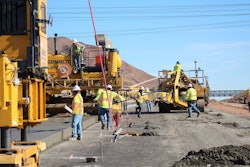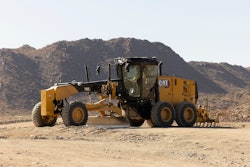
Good news: The Trump Administration on Monday announced a wide-ranging program to boost funding and change the way apprenticeship programs are managed in the United States. These new apprenticeships would be run by businesses and industry associations, called Industry Recognized Apprentice Programs (IRAPs), in partnerships with schools.
Bad news: As of the announcement Monday, construction apprenticeships may not be included in the plan even though the construction industry is the single largest source of apprenticeships in the country.
Why exclude construction? According to several construction and contractor associations, the construction unions want to funnel workers through their own programs. Citing safety issues, North America’s Building Trades Unions (NABTU) president Sean McGarvey sent out a statement Wednesday that said: “These programs have no place in the construction industry. We firmly believe this exemption should be a permanent part of the final rule.”
The Labor Department, which drafted the plan, had said previously the construction industry should not be eligible to form its own IRAPs, but would continue to use the existing federal oversight program known as the Registered Apprenticeship system. In this system, the government sets the rules and monitors the programs with little or no input from private industry.
According to Bloomberglaw.com, Labor Department Secretary Alexander Acosta sides with the unions and wants to exclude the construction trades, but the country’s non-union builders have the support of many in the White House including the acting chief of staff Mick Mulvaney.
A draft of the legislation sent to the White House this week leaves the issue unresolved. But Mulvaney recently established a system whereby disputes between the Labor Department and the White House can be settled by a yes or no vote by himself.
Pros and cons
The construction industry has long argued for an apprenticeship program that is tailored to the real world needs of companies doing the work rather than teaching young people skills and systems that may be years, even decades behind actual practice and technology. And many community colleges add elective humanities or non-relevant courses as a requirement for graduation, which pads their payrolls but delays the students’ entry into the career field. The Trump administration has said as much, claiming the current system is “too burdensome and discourages companies and trade groups from starting new programs.”
The utilization of GPS/GNSS technology is one example. Very few teachers in the community college system have experience with these systems and few schools can afford the technology. Likewise new products and materials that are adopted with lightning speed in the industry can take decades to get recognized in a government-run educational system. As a result, graduates of construction management and equipment operation programs have no knowledge of important innovations that are widespread throughout the industry and vital to its success.
The establishment of IRAPs for construction apprentices would do a lot to rectify these shortcomings. But critics say that the IRAPs might create conflicts of interest—or because they’re industry run and regulated—give short shrift to safety.
Other than the stiff-arm given to the construction trades, the notice for proposed rulemaking sent to the White House is a serious piece of work and includes funding to the tune of $183.8 million to support the development and expansion of apprenticeships for educational institutions that partner with companies that provide a funding match component. The department will also make available an additional $100 million for efforts to expand apprenticeships and close the skills gap.
President Trump has long advocated for a reform of our nation’s apprenticeship programs. In June of 2017 he signed Executive Order 13801 that created a task force on apprenticeship expansion that included representatives of business, labor, educational institutions, trade associations and public officials.
If the proposed rule becomes law and includes the construction trades, it would mark a watershed moment for the industry and bring long-overdue reforms to its moribund apprentice training. Apprenticeship training throughout Europe includes many of the industry-friendly, industry-involved aspects of the Labor Department’s proposed IRAPs and is at least partially responsible for Europe’s ability to complete infrastructure projects faster and at less cost than the U.S.
But the potential exclusion of construction training is bound to be controversial on two counts.
First: Despite the union’s vigorous opposition, only 12.8 percent of construction workers in the United States are unionized. That’s 1.1 million unionized vs. 7.8 million non-union, and the unions’ numbers are shrinking. The Trump administration must certainly weigh the consequences of shortchanging almost 8 million blue collar, construction worker voters this close to the 2020 election if it allows the construction exemption.
Second: As it stands now, IRAPs in the Labor Department proposal will fund barista training for Starbucks franchises and yet ignore high-skill training for construction workers, many of whom could earn $60,000 their first year and have a career for life. Favoring low-wage, low-skill, low-pay work over good paying, career construction jobs won’t strengthen the middle class, boost the economy or help solve the infrastructure crisis. Anybody can make a cup of coffee. Not everybody can build a bridge.
The public comment period for the proposed rule ends August 26. If you’d like more details or wish to comment, you’ll find more information here.










